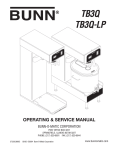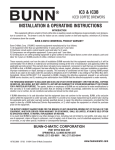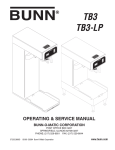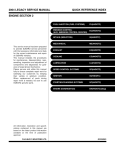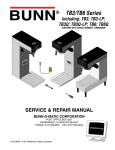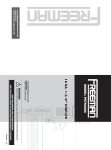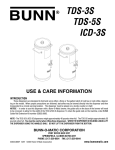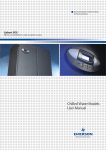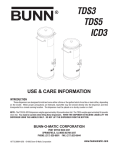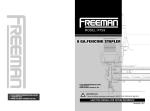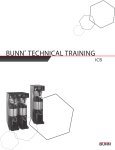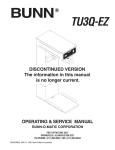Download Bunn TU3Q Service manual
Transcript
TU3Q
QU
ICK
W
BRE
DISCONTINUED VERSION
The information in this manual
is no longer current.
OPERATING & SERVICE MANUAL
BUNN-O-MATIC CORPORATION
POST OFFICE BOX 3227
SPRINGFIELD, ILLINOIS 62708-3227
PHONE: (217) 529-6601 FAX: (217) 529-6644
10288.0000N
03/04 ©1988 Bunn-O-Matic Corporation
www.bunnomatic.com
CONTENTS
User Notices .................................................................... 3
Electrical & Plumbing Requirements ............................... 4
Initial Set-Up .................................................................... 5
Auto Sweetener Set-Up .................................................... 5
Adjusting Brew Volumes .................................................. 6
Operating Controls ........................................................... 7
Cleaning ........................................................................... 7
Auto Sweetener Cleaning ................................................. 7
Tea Brewing ..................................................................... 8
Troubleshooting ............................................................... 9
Service ........................................................................... 14
Wiring Diagrams ............................................................ 25
INTRODUCTION
This equipment will brew a three gallon batch of fresh tea into an awaiting dispenser. The tea will be dispensed at
approximately room temperature to conserve ice. The brewer is only for indoor use on a sturdy counter or shelf.
BUNN-O-MATIC COMMERCIAL PRODUCT WARRANTY
Bunn-O-Matic Corp. (“BUNN”) warrants equipment manufactured by it as follows:
1) All equipment other than as specified below: 2 years parts and 1 year labor.
2) Electronic circuit and/or control boards: parts and labor for 3 years.
3) Compressors on refrigeration equipment: 5 years parts and 1 year labor.
4) Grinding burrs on coffee grinding equipment to grind coffee to meet original factory screen sieve analysis: parts and
labor for 3 years or 30,000 pounds of coffee, whichever comes first.
These warranty periods run from the date of installation BUNN warrants that the equipment manufactured by it
will be commercially free of defects in material and workmanship existing at the time of manufacture and appearing
within the applicable warranty period. This warranty does not apply to any equipment, component or part that was not
manufactured by BUNN or that, in BUNN’s judgment, has been affected by misuse, neglect, alteration, improper installation
or operation, improper maintenance or repair, damage or casualty. This warranty is conditioned on the Buyer 1) giving
BUNN prompt notice of any claim to be made under this warranty by telephone at (217) 529-6601 or by writing to Post
Office Box 3227, Springfield, Illinois 62708-3227; 2) if requested by BUNN, shipping the defective equipment prepaid to
an authorized BUNN service location; and 3) receiving prior authorization from BUNN that the defective equipment is
under warranty.
THE FOREGOING WARRANTY IS EXCLUSIVE AND IS IN LIEU OF ANY OTHER WARRANTY, WRITTEN OR ORAL,
EXPRESS OR IMPLIED, INCLUDING, BUT NOT LIMITED TO, ANY IMPLIED WARRANTY OF EITHER MERCHANTABILITY
OR FITNESS FOR A PARTICULAR PURPOSE. The agents, dealers or employees of BUNN are not authorized to make
modifications to this warranty or to make additional warranties that are binding on BUNN. Accordingly, statements by
such individuals, whether oral or written, do not constitute warranties and should not be relied upon.
If BUNN determines in its sole discretion that the equipment does not conform to the warranty, BUNN, at its
exclusive option while the equipment is under warranty, shall either 1) provide at no charge replacement parts and/or
labor (during the applicable parts and labor warranty periods specified above) to repair the defective components, provided
that this repair is done by a BUNN Authorized Service Representative; or 2) shall replace the equipment or refund the
purchase price for the equipment.
THE BUYER’S REMEDY AGAINST BUNN FOR THE BREACH OF ANY OBLIGATION ARISING OUT OF THE SALE
OF THIS EQUIPMENT, WHETHER DERIVED FROM WARRANTY OR OTHERWISE, SHALL BE LIMITED, AT BUNN’S SOLE
OPTION AS SPECIFIED HEREIN, TO REPAIR, REPLACEMENT OR REFUND.
In no event shall BUNN be liable for any other damage or loss, including, but not limited to, lost profits, lost
sales, loss of use of equipment, claims of Buyer’s customers, cost of capital, cost of down time, cost of substitute
equipment, facilities or services, or any other special, incidental or consequential damages.
Page 2
10288 031604
USER NOTICES
Carefully read and follow all notices on the equipment and in this manual. They were written for your protection. All notices on the equipment should be kept in good condition. Replace any unreadable or damaged labels.
#00831.0000
!
WARNING
Fill water tank before turning -on
thermostat or connecting appliance
to power source.
Use only on a properly protected
circuit capable of the rated load.
Electrically ground the chassis.
Follow natinal/local electrical codes.
Do not use near combustibles.
FAILURE TO COMPLY RISKS EQUIPMENT
DAMAGE, FIRE, OR SHOCK HAZARD
READ THE ENTIRE OPERATING MANUAL
BEFORE BUYING OR USING THIS PRODUCT
THIS APPLIANCE IS HEATED WHENEVER
CONNECTED TO A POWER SOURCE
00831.0000F 3/98 ©1988 BUNN-O-MATIC CORPORATION
#00656.0000
#03408.0002
#03409.0002
#03408.0000
#03536.0000
#03409.0000
Page 3
10288 031604
ELECTRICAL REQUIREMENTS
CAUTION - The brewer must be disconnected from the power source until specified in Initial Set-Up.
120V model brewers require 2-wire, grounded service rated 120 volts ac, 15 amp, single phase, 60 Hz.
"A" model brewers require 2-wire, grounded service rated 230 volts ac, 10 amp, single phase, 50 Hz.
"B" model brewers require 2-wire, grounded service rated 100 volts ac, 15 amp, single phase, 60 Hz.
Proceed as follows:
Electrical Hook-Up
CAUTION - Improper electrical installation will damage electronic components.
1. An electrician must provide electrical service as specified.
2. Using a voltmeter, check the voltage and color coding of each conductor at the electrical source.
3. Remove top cover from the brewer.
4. Rotate the control thermostat knob fully counterclockwise to the "OFF" position and replace the top cover.
5. Connect the brewer to the power source.
6. If plumbing is to be hooked up later be sure the brewer is disconnected from the power source. If plumbing
has been hooked up, the brewer is ready for Initial Set-Up.
PLUMBING REQUIREMENTS
These brewers must be connected to a cold water system with operating pressure between 20 and 90 psi
(138 and 621 kPa) from a 1⁄2" or larger supply line. A shut-off valve should be installed in the line before the
brewer. Install a regulator in the line when pressure is greater than 90 psi (621kPa) to reduce it to 50 psi (345
kPa). The water inlet fitting is 1⁄4" flare.
NOTE: Bunn-O-Matic recommends 1⁄4" copper tubing for installations of less than 25 feet and 3⁄8" for more than
25 feet from the 1⁄2" water supply line. A tight coil of copper tubing in the water line will facilitate moving the
brewer to clean the countertop. Bunn-O-Matic does not recommend the use of a saddle valve to install the
brewer. The size and shape of the hole made in the supply line by this type of device may restrict water flow.
This equipment must be installed to comply with the Basic Plumbing Code of the
Building Officials and Code Administrators International, Inc. (BOCA)
and the Food Service Sanitation Manual of the Food and Drug Administration (FDA).
Standard Flow Control
Quiet Flow Control
Page 4
10288 031604
PLUMBING REQUIREMENTS (cont.)
1.
2.
3.
4.
Remove the shipping cap from the bulkhead fitting on the rear of the brewer.
Attach the flare fitting from the short piece of tubing on the strainer/flow control (supplied) to the water inlet
fitting at the rear of the brewer.
Flush the water line and securely attach it to the flare fitting on the strainer/flow control.
Turn on the water supply.
INITIAL SET-UP
CAUTION - The brewer must be disconnected from the power source throughout the Initial Set-Up, except
when specified in the instructions.
1. Remove the top lid from the brewer.
2. Rotate the control thermostat knob fully counterclockwise to the "OFF" position and replace the top lid.
3. Insert an empty funnel into the funnel rails.
4. Place an empty dispenser on the brewer base. Be prepared to empty the dispenser during these initial steps.
5. Plug in the brewer, place the ON/OFF switch in the "ON" position ("SWEET" or "UNSWEET" position for
brewers with a sweetener option), and momentarily press the START switch. Water will flow into the tank
and dispenser for three and one-half minutes. Empty the dispenser when this first cycle stops and press the
START switch again. Empty the dispenser when the second cycle stops and press the START switch once
more. During the third cycle, the tank will fill to its capacity and the excess will flow from the funnel into the
dispenser. Empty the dispenser when this third cycle stops.
6. Begin another brew cycle and measure the total water volume from the dispenser. It should be approximately 3 gallons and 12 ounces. (396 ounces). CONCENTRATE MACHINES WILL YIELD ONLY 76 OZ.
7. If not, adjust the timer as required. See Adjusting Brew Volumes.
8. Start, and measure another cycle.
9. Repeat steps 6-8 until the recommended total water volume is achieved.
10. The concentrate valve is pre-adjusted to deliver the correct ratio of brew water to dilution water.
11. Unplug the brewer, remove the top lid, rotate the control thermostat knob fully clockwise to the "ON" position and replace the top lid.
12. Empty the dispenser.
13. Plug in the brewer and wait for the water in the tank to heat to brewing temperature (approximately 20
minutes). Some water will drip from the funnel during this time; this is due to expansion and should not
occur thereafter.
14. Begin another brew cycle. Empty the reservoir after water has stopped flowing from the funnel.
15. Allow the water in the tank to heat to the proper temperature.
16. The brewer is now ready to brew approximately 3 gallons of freshly brewed room temperature tea from
three to five ounces of loose leaves.
AUTO SWEETENER SET-UP
CAUTION - The brewer must be disconnected from the power source throughout the Initial Set-Up, except
when specified in the instructions.
1. Remove the top lid and both rear panels.
2. Make sure the brewer water supply is off.
3. Connect sweetener hose from the bag in a box delivery system to the rear fitting marked "Sweetener" .
IMPORTANT - System delivery pressure must be regulated between 30-40 psi. System also needs to deliver
Page 5
10288 031604
AUTO SWEETENER SET-UP (cont.)
product for at least 4 minutes without shutting off. Some pump systems shut off after a few minutes of continuous running.
4. Plug brewer into the power source.
5. Place an empty reservoir under the dilution nozzle of the brewer.
6. Close the adjustment valve on the rear of the brewer fully (clockwise), then open (counterclockwise) 1/2
turn.
7. Set the selector switch to the "Sweetened" side and press the "Start" switch momentarily. (The sweetener will
come out immediately.)
8. Run sweetener for 1 minute, then set selector switch to the "Off" position. The flow will stop.
9. Measure the amount of sweetener dispensed and calculate if the volume needs to be increased or decreased
(Dilution cycle is usually between 3 to 3 1/2 minutes).
10. If adjustment is needed, turning the adjustment valve clockwise decreases the amount of sweetener dispensed and turning the adjustment valve counterclockwise increases the amount of sweetener dispensed.
11. After the desired volume has been set, turn the water supply on.
12. Reinstall the top lid, lower and upper rear panels.
The brewer may now be returned to service.
ADJUSTING BREW VOLUMES
CAUTION - Disconnect the power source from the brewer prior to the removal of any panel for the replacement
or adjustment of any component.
NOTE: Prior to setting or modifying batch sizes, check that the brewer is connected to water supply, the tank is
properly filled, and a funnel and server are in place.
1. Modifying batch sizes. To modify a batch volume, first check that the SET/LOCK switch is in the “SET”
position on the circuit board.
To increase a batch size. Press and hold the START or BREW switch until three clicks are heard. Release the
switch (Failure to release the switch within two seconds after the third click causes the volume setting to be
aborted and previous volume setting will remain in memory) and press it again one or more times. Each time
the switch is pressed, two seconds are added to the brew time period. Allow the brew cycle to finish in order
to verify that the desired volume has been achieved.
To decrease a batch size. Press and release the START or BREW switch once for every two-second interval to
be removed from the total brew time period; then immediately press and hold down the START or BREW
switch until three clicks are heard. Release the switch. (Failure to release the switch within two seconds after
the third click causes the volume setting to be aborted and previous volume setting will remain in memory).
Allow the brew cycle to finish in order to verify that the desired volume has been achieved.
2. Setting batch sizes. To set a batch volume, first check that the SET/LOCK switch is in the “SET” position on
the circuit board. Press and hold the START or BREW switch until three distinct clicks are heard, and then
release the switch. (Failure to release the switch within two seconds after the third click causes the volume
setting to be aborted and previous volume setting will remain in memory). View the level of the liquid being
dispensed. When the desired level is reached, turn the ON/OFF (UNSWEET/OFF/SWEET) switch to “OFF” .
The brewer remembers this volume and will continue to brew batches of this size until the volume setting
procedure is repeated.
NOTE: When brewing tea, batch volumes will decrease due to absorption by the tea leaves.
3. Setting programming disable feature. If it becomes necessary to prevent anyone from changing brew times
once programmed, you can set the SET/LOCK switch to the “LOCK” position. This will prevent any programming to be done until switch is once again placed in the “SET” position.
Page 6
10288 031604
OPERATING CONTROLS
A. ON/OFF Switch
ON - Placing the switch in the left position allows the start switch to activate a timed brew cycle for three gallons
of tea.
OFF - Placing the switch in the right position stops the brew cycle. Stopping a brew cycle after it has been started
will not stop the flow of water into the funnel until the tank syphons down to its proper level. The switch should
always be placed in this position after a brew cycle and whenever the brewer is unattended.
B. Start Switch
Starts a brew cycle when the ON/OFF switch is in the "ON" position.
Starts a brew cycle when the UNSWEET/OFF/SWEET switch is in either the "UNSWEET" or "SWEET" position.
(Models with Sweetener Only)
C. OFF/SELECTOR Switch (Models with Sweetener Only)
UNSWEET - Placing the switch in the left positional allows the start switch to activate a timed brew cycle for three
gallons of tea without sweetener.
OFF - Placing the switch in the middle position stops the brew cycle. Stopping a brew cycle after it has been started
will not stop the flow of water into the funnel until the tank syphons down to its proper level. The switch should
always be placed in this position after a brew cycle and whenever the brewer is unattended.
SWEET - Placing the switch in the right positional allows the start switch to activate a timed brew cycle for three
gallons of tea with sweetener.
CLEANING
CAUTION - CLEAN AND SANITIZE YOUR ICED TEA BREWER DAILY
1. Remove and thoroughly clean the entire brew funnel. The funnel tip and screen must be free from any tea
particles or residue. Reassemble the funnel.
2. Unplug the brewer. Remove and thoroughly rinse the sprayhead. The holes must be open and clear of any
mineral deposits. Wipe the sprayhead panel clean with a damp cloth.
3. Insert the deliming spring into the sprayhead fitting until no more than one inch is visible and move it in and
out 5 or 6 times. Reattach the sprayhead.
4. Wash the entire outside surface of the brewer with a clean damp cloth.
CAUTION - DO NOT KEEP BREWED ICED TEA OVERNIGHT. THE SERVER MUST BE CLEANED DAILY.
AUTO SWEETENER CLEANING
1.
2.
3.
4.
5.
6.
7.
Remove the connector off of the bag in a box.
Place the end in a bucket of hot water (120°-130°F)
Place an empty reservoir on the base under the dilution nozzle.
Set the selector switch to the "Sweetened" setting.
Press and release the "Start" switch.
Run three brew cycles in a row, emptying the reservoir after each cycle.
When the three cycles have been completed, hook the connector back up to the bag in a box system. (This
will keep buildup from occurring in the system.)
This procedure should be performed weekly or as needed to keep the system clear.
Page 7
10288 031604
TEA BREWING
1.
Begin each brew cycle with a clean empty brew funnel and server. (Be sure the server lid doesn’t interfere
with the flow of dilution water.)
2. Insert a BUNN® filter into the funnel.
3. Pour the packet of loose fresh tea leaves into the filter. Approximately three to five ounces is recommended
for three gallons of beverage.
4. Level the bed of tea leaves by gently shaking.
5. Slide the funnel into the funnel rails until it stops.
6. Place the ON/OFF switch in the “ON” position. (For brewers with a sweetener, place the UNSWEET/OFF/
SWEET switch in the "SWEET" or "UNSWEET" position.)
7. Momentarily press the START switch.
CAUTION - The funnel contains hot liquids. Remove funnel slowly.
8. Carefully remove the brew funnel and discard the used filter when tea no longer drips from the funnel tip.
9. Place the ON/OFF (UNSWEET/OFF/SWEET) switch in the "OFF" position to prevent a false start.
10. Fresh tea is available at the faucet.
Page 8
10288 031604
TROUBLESHOOTING
A troubleshooting guide is provided to suggest probable causes and remedies for the most likely problems
encountered. If the problem remains after exhausting the troubleshooting steps, contact the Bunn-O-Matic
Technical Service Department.
•
•
•
•
•
•
•
Inspection, testing, and repair of electrical equipment should be performed only by qualified service personnel.
All electronic components have 120 volt ac and low voltage dc potential on their terminals. Shorting of
terminals or the application of external voltages may result in board failure.
Intermittent operation of electronic circuit boards is unlikely. Board failure will normally be permanent. If an
intermittent condition is encountered, the cause will likely be a switch contact or a loose connection at a
terminal or crimp.
Solenoid removal requires interrupting the water supply to the valve. Damage may result if solenoids are
energized for more than ten minutes without a supply of water.
The use of two wrenches is recommended whenever plumbing fittings are tightened or loosened. This will
help to avoid twists and kinks in the tubing.
Make certain that all plumbing connections are sealed and electrical connections tight and isolated.
This brewer is heated at all times. Keep away from combustibles.
WARNING –
• Exercise extreme caution when servicing electrical equipment.
• Unplug the brewer when servicing, except when electrical tests are specified.
• Follow recommended service procedures
• Replace all protective shields or safety notices
Problem
Probable Cause
Remedy
Brew cycle will not start
1. No water
Water lines and valves to the brewer
must be open.
2. No power or incorrect voltage to
the brewer
Check circuit breakers or fuses.
3. External Strainer/Flow Control
(.750 GPM)
(A) Direction of flow arrow must be
pointing towards the brewer.
(B) Remove the strainer/flow control and check for obstructions.
Clear or replace.
4. ON/OFF (UNSWEET/OFF/SWEET)
Switch
Refer to Service - ON/OFF Switch
for testing. See page 21. For OFF/
SELECTOR switch See page 25.
5. Start Switch
Refer to Service - Start Switch for
testing procedures. See page 22.
Page 9
10288 031604
TROUBLESHOOTING (cont.)
PROBLEM
PROBABLE CAUSE
REMEDY
Brew cycle will not start (cont.)
6. Brew Timer
Refer to Service - Brew Timer for
testing procedures. See page 16 or
17.
7. Brew Solenoid Valve
Refer to Service - Brew Solenoid
Valve for testing procedures. See
page 15.
1. Limit Thermostat
CAUTION - Do not eliminate or bypass limit thermostat or thermal
cut-off. Use only BOM replacement
part #29329.1000
Refer to Service - Limit Thermostat
for testing procedures. See page
20.
2. Control Thermostat
Refer to Service - Control Thermostat for testing procedures. See
page 19.
3. Tank Heater
Refer to Service - Tank Heater for
testing procedures. See page 23.
1. ON/OFF (UNSWEET/OFF/SWEET)
Switch
Refer to Service - ON/OFF Switch
for testing. See page 21. For OFF/
SELECTOR switch See page 25.
2. Start Switch
Refer to Service - Start Switch for
testing procedures. See page 22.
1. Syphon System
The brewer must be level or slightly
lower in front to syphon properly.
2. Lime Build-up
CAUTION - Tank and tank components should be delimed regularly
depending on local water conditions. Excessive mineral build-up
on stainless steel surfaces can initiate corrosive reactions resulting
in serious leaks.
Inspect the tank assembly for excessive lime deposits. Delime as
required.
3. Water Pressure
The water pressure to the brewer
must be at least 20 psi (138 kPa).
Water is not hot
Dilution cycle will not start
Inconsistent beverage level in
dispenser
Page 10
10288 031604
TROUBLESHOOTING (cont.)
PROBLEM
PROBABLE CAUSE
REMEDY
Consistently high or low beverage
level in the dispenser
1. External Strainer/Flow Control
(.750 GPM)
(A) Direction of flow arrow must be
pointing towards brewer.
(B) Remove the strainer/flow control and check for obstructions.
Clear or replace.
Spitting or excessive steaming
1. Lime Build-up
CAUTION - Tank and tank components should be delimed regularly
depending on local water conditions. Excessive mineral build-up
on stainless steel surfaces can initiate corrosive reactions resulting
in serious leaks.
Inspect tank assembly for excessive
lime deposits. Delime as required.
2. Control Thermostat
Refer to Service - Control Thermostat for testing procedures. See
page 19.
Drip-out time too long
1. Funnel Tip
The brew funnel should be cleaned
thoroughly before each brew cycle
to lessen the chance of tea leaf particles clogging the drip-out tip.
Sweetener is not working
1. Sweetener box is empty
Check the Sweetener box to make
sure it is not out of product.
2. Flow Adjustment screw is closed
Check the Flow Adjustment screw
to make sure the valve has not
closed.
3. Solenoid is defective
Refer to Service -Sweetener Solenoid Valve for testing procedures.
See page 24.
3. The Pump is defective
Check the manufacturers warranty
for additional information on testing and replacement of a defective
pump.
Page 11
10288 031604
TROUBLESHOOTING (cont.)
PROBLEM
Dripping from sprayhead
PROBABLE CAUSE
1. Syphon System
REMEDY
The brewer must be level or slightly
lower in front to syphon properly.
2. Lime Build-up
CAUTION - Tank and tank components should be delimed regularly
depending on local water conditions. Excessive mineral build-up
on stainless steel surfaces can initiate corrosive reactions resulting
in serious leaks.
Inspect the tank assembly for excessive lime deposits. Delime as
required.
3. Brew Solenoid Valve
Refer to Service - Brew Solenoid
Valve for testing procedures. See
page 15.
Water flows into tank continuously
(ON/OFF Switch "ON")
(UNSWEET/OFF/SWEET Switch in
"UNSWEET" or "SWEET" position)
1. Brew Timer
Refer to Service - Brew Timer for
testing procedures. See page 16 or
17.
Water flows into tank continuously
(ON/OFF Switch "OFF")
(UNSWEET/OFF/SWEET Switch in
"UNSWEET" or "SWEET" position.
1. Brew Solenoid Valve
Refer to Service - Brew Solenoid
Valve for testing procedures. See
page 15.
Beverage overflows dispenser
1. Dispenser
The dispenser must be completely
empty before starting a brew cycle.
2. Brew Timer
Refer to Service - Brew Timer for
testing procedures. See page 16 or
17.
3. Brew Solenoid Valve
Remove the Brew Solenoid Valve
and clean any obstruction. Rebuild
or replace the valve if necessary.
See page 15.
1. Filter Type
BUNN® paper filters must be used
for proper extraction.
2. Tea
A sufficient quantity of fresh, loose
tea leaves should be used for proper
extraction.
3. Sprayhead
A clean stainless steel sprayhead
must be used for proper extraction.
10288 031604
Weak beverage
Page 12
TROUBLESHOOTING (cont.)
PROBLEM
PROBABLE CAUSE
REMEDY
Weak beverage (cont.)
4. Funnel Loading
The BUNN® paper filter must be
centered in the funnel and the bed
of tea leaves leveled by gentle shaking.
5. Water Temperature
Place an empty funnel on an empty
dispenser beneath the sprayhead.
Initiate a brew cycle and check the
water temperature immediately below the sprayhead with a thermometer. The reading should not be less
than 200°F (93°C). Adjust the control thermostat to increase the water temperature. Replace if necessary.
6. Low Brew Water Volume
Adjust needle valve to achieve 76
oz. water from the sprayhead. To
increase volume, turn counterclockwise. To decrease volume,
turn clockwise.
Dry tea leaves remain in the funnel
1. Funnel Loading
The BUNN® paper filter must be
centered in the funnel and the bed
of tea leaves leveled by gently shaking.
Brewer is making unusual noises
1. Solenoid(s)
The nut on the solenoid(s) must be
tight or it will vibrate during operation.
2. Plumbing Lines
Plumbing lines should not be resting on the counter top.
3. Water Supply
(A) The brewer must be connected
to a cold water line.
(B) Water pressure to the brewer
must not exceed 90 psi (621 kPa).
Install a regulator if necessary to
lower the working pressure to approximately 50 psi (345 kPa).
4. Tank Heater
Page 13
Remove and clean lime off the tank
heater. See page 23.
10288 031604
SERVICE
This section provides procedures for testing and
replacing various major components used in this
brewer should service become necessary. Refer to
Troubleshooting for assistance in determining the
cause of any problem.
WARNING - Inspection, testing, and repair of electrical equipment should be performed only by qualified
service personnel. The brewer should be disconnected
from the power source when servicing, except when
electrical tests are required and the test procedure specifically states to plug-in the brewer.
COMPONENT ACCESS
WARNING - Disconnect the brewer from the power
source before the removal of any panel or the replacement of any component.
All components are accessible by the removal of
the top cover and rear inspection panel.
The top cover is attached with four #6-32 screws.
Removal of the top cover will allow access to ON/OFF
(UNSWEET/OFF/SWEET) switch, START switch, brew
timer, brew solenoid, control thermostat, limit thermostat and tank heater.
Contents
FIG. 1 COMPONENT ACCESS
P2092.40
Brew Solenoid Valve ............................................ 15
Brew Timer (Early Models) .................................. 16
Digital Brew Timer (Late Models) ........................ 17
Control Thermostat .............................................. 19
Limit Thermostat ................................................. 20
ON/OFF Switch..................................................... 21
Start Switch ......................................................... 22
Tank Heater .......................................................... 23
Sweetener Solenoid Valve .................................... 24
OFF/SELECTOR Switch (Sweetener Option)......... 25
Wiring Diagrams .................................................. 26
Page 14
10288 031604
SERVICE (cont.)
BREW SOLENOID VALVE
If continuity is not present as described, replace the
solenoid valve.
6. Check the solenoid valve for coil action. Connect
the brewer to the power source. With ON/OFF
switch in the "ON" position ("UNSWEET" position
for brewers with sweetener option), press START
switch and listen carefully in the vicinity of the
solenoid valve for a "clicking" sound as the coil
magnet attracts.
7. Disconnect the brewer from the power source.
If the sound is heard as described and water will not
pass through the solenoid valve, there may be a blockage in the water line before the solenoid valve or, the
solenoid valve may require inspection for wear, and
removal of waterborne particles.
If the sound is not heard as described, replace the
solenoid valve.
FIG. 2 BREW SOLENOID VALVE
P2087.40
Location:
Viewing the brewer from the top, the brew solenoid valve is mounted on the right side of the brewer.
Test Procedures:
1. Disconnect the brewer from the power source.
2. Disconnect the white/violet and white/green wires
from the solenoid valve. With the ON/OFF switch
in the "ON" position ("UNSWEET" or "SWEET" position for brewers with sweetener option), press
the start switch.
3. With a voltmeter, check the voltage across the
white/violet and white/green wires. Connect the
brewer to the power source. The indication must
be:
a) 120 volts ac for two wire 120 volt models.
b) 230 volts ac for two wire 230 volt models.
c) 100 volts ac for two wire 100 volt models.
4. Disconnect the brewer from the power source,
Removal and Replacement:
1. Remove all wires from solenoid valve.
2. Turn off the water supply to the brewer.
3. Disconnect the water lines to and from the solenoid valve.
4. Remove the two #8-32 keps nuts holding the
mounting bracket to the hood.
5. Lift out the bracket.
6. Remove the two #10-32 slotted-head screws holding the solenoid valve to the mounting bracket.
7. Securely install the new solenoid valve to the
mounting bracket.
8. Attach the mounting bracket to the hood.
9. Securely fasten the water lines to and from the
solenoid valve.
10. Refer to the Fig. 3 when reconnecting the wires.
WHI/VIO to
Brew Timer TL1
If voltage is present as described, proceed to #5
If voltage is not present as described, refer to Wiring
Diagrams and check brewer wiring harness.
WHI/GRN to
Brew Timer TL4
BREW SOLENOID
5. Check for continuity across the solenoid valve coil
terminals.
If continuity is present as described, reconnect the
white/violet from the brew timer and white/green wire
from the brew timer.
Page 15
P2843
FIG. 3 SOLENOID VALVE TERMINALS
10288 031604
SERVICE (cont.)
BREW TIMER (Early Models)
If continuity is not present as described, refer to the
Wiring Diagram and check the wiring harness.
.
ES IC
UT AT C
MIN-O-M 0 VA
NN - 12
BU 20
26
P/N
FIG. 4 BREW TIMER
P2088.50
Location:
The brew timer is located in the hood. It consists
of the dial plate and circuit board.
Test Procedure:
1. Disconnect the brewer from the power source.
2. Remove the wires from terminals TL3, TL4, & TL5
of the timer and rotate the dial fully counterclockwise.
3. With a voltmeter, check the voltage across terminals TL1 and TL2 when the ON/OFF switch is in
the “ON” position. Connect the brewer to the power
source. The indication must be:
a) 120 volts ac for two wire 120 volt models.
b) 230 volts ac for two wire 230 volt models.
c) 100 volts ac for two wire 100 volt models.
4. Disconnect the brewer from the power source.
If voltage is present as described, proceed to #5.
If voltage is not present as described, refer to the Wiring Diagram and check the wiring harness.
6. With a voltmeter, check the voltage across terminals TL1 and TL4 when the ON/OFF switch is in
the “ON” position and the START switch is momentarily placed in the lower position. Connect
the brewer to the power source. The indication
must be:
a) 120 volts ac for two wire 120 volt models for
approximately twenty seconds and then return
to its previous indication.
b) 230 volts ac for two wire 230 volt models for
approximately twenty seconds and then return to
is previous indication.
c) 100 volts ac for two wire 100 volt models for
approximately twenty seconds and then return to
its previous indication.
7. Disconnect the brewer from the power source.
If voltage is present as described, the timer is operating properly. Adjust the timer dial as required.
If voltage is not present as described, replace the timer.
Removal and Replacement:
1. Remove all wires from the timer.
2. Remove the circuit board and dial plate from the
brackets.
3. Install new timer circuit board as described in Late
Model Timer section on the following pages.
4. Refer to Fig. 7 when reconnecting the wires.
5. Install the Timer Setting decal, provided with the
replacement timer kit, to the rear of the schematic
beneath the top cover.
6. Adjust the timer as required. Refer to Late Model
Timer section on the following pages.
5. Check for continuity across the white/orange and
white/yellow wires when the START switch is held
in the lower position.
If continuity is present as described, reconnect the
wires to terminals TL3, TL4, & TL5 of the timer board
and proceed to #6.
Page 16
OLD STYLE
FIG. 5 BREW TIMER TERMINALS
P2089.75
10288 030201
SERVICE (cont.)
DIGITAL BREW TIMER (Late Models)
6. With a voltmeter, check the voltage across terminals TL1 and TL4 when the "ON/OFF" switch is in
the "ON" position. Connect the brewer to the power
source. The indication must be 0 volts.
If voltage is as described, proceed to #7.
If voltage is not as described, disconnect the brewer
from the power source and replace the timer.
7. With a voltmeter, check the voltage across terminals TL1 and TL4 when the "ON/OFF" switch is in
the "ON" position. Connect the brewer to the power
source and press the "START" switch. The indication must be as follows:
a) 120 volts ac for two wire 120 volt models.
b) 230 volts ac on two wire 230 volt models.
c) 100 volts ac for two wire 100 volt models.
FIG. 6 DIGITAL BREW TIMER
P2200.50
Location:
The timer is located inside the hood, on the left
side.
Test Procedure.
NOTE: Do not remove or install wires while timer
board is installed. Pressure applied to one side may
cause damage to the board.
1. Disconnect the brewer from the power source and
remove the top cover.
2. Remove the two #8-32 screws securing circuit
board to the mounting bracket.
3. Remove circuit board and spacers (as required).
4. With a voltmeter, check the voltage across terminals TL1 and TL2 when the "ON/OFF" switch is in
the "ON" position. Connect the brewer to the power
source. The indication must be:
a) 120 volts ac for two wire 120 volt models
b) 230 volts ac for two wire 230 volt models.
c) 100 volts ac for two wire 100 volt models.
5. Disconnect the brewer from the power source.
If voltage is present as described, proceed to #6.
If voltage is not present as described, refer to the
Wiring Diagrams and check the brewer wiring harness.
If voltage is present as described, the brew timer is
operating properly. Reset the timer as required, to
obtain the desired brew volume.
If voltage is not present as described, disconnect the
brewer from the power source and replace the timer.
Removal and Replacement:
1. Remove the two #8-32 screws securing circuit
board to the mounting bracket.
2. Remove circuit board and spacers (as required).
3. Remove all wires from the timer.
4. Attach all wires to the replacement timer board
prior to installation to the component mounting
bracket. Refer to FIG. 7 when reconnecting the
wires.
5. Install new circuit board with spacers (as required) to the hood.
6. Adjust the timer as described below.
Timer Setting:
NOTE: Prior to setting or modifying volumes, check
that the brewer is connected to water supply, the tank
is properly filled, and a funnel and server are in place.
NOTE: All volume settings must be done with the
sprayhead installed.
1. Modifying brew volumes. To modify a brew volume, first check that the SET/LOCK switch is in the
“SET” position on the circuit board.
Page 17
10288 071000
SERVICE (cont.)
DIGITAL BREW TIMER (Late Models) (cont.)
To increase a brew volume, place the ON/OFF
switch in the “ON” position, press and hold the START
switch until three clicks are heard. Release the switch
and press it again one or more times. (Failure to release the switch within two seconds after the third
click causes the volume setting to be aborted and previous volume setting will remain in memory.) Each
time the switch is pressed, two seconds are added to
the brew time period. Allow the brew cycle to finish in
order to verify that the desired volume has been
achieved.
NOTE: When brewing coffee, volume will decrease due
to absorption by the coffee grounds.
3. Setting programming disable feature. If it becomes
necessary to prevent anyone from changing brew time
once programmed, you can set the SET/LOCK switch
to the “LOCK” position. This will prevent any further
programming until switch is once again put into the
“SET” position.
To decrease a brew volume, place the ON/OFF
switch in the “ON” position, press and release the
START switch once for every two-second interval to
be removed from the total brew time period; then immediately press and hold down the START switch until
three clicks are heard. Release the switch. (Failure to
release the switch within two seconds after the third
click causes the volume setting to be aborted and previous volume setting will remain in memory). Allow
the brew cycle to finish in order to verify that the desired volume has been achieved.
2. Setting brew volumes. To set a brew volume, first
check that the SET/LOCK switch is in the “SET” position on the circuit board. Place the ON/OFF switch in
the “ON” position, press and hold the START switch
until three distinct clicks are heard and then release
the switch. (Failure to release the switch within two
seconds after the third click causes the volume setting to be aborted and previous volume setting will
remain in memory.)
View the level of the liquid being dispensed. When
the desired level is reached, turn the ON/OFF switch
to “OFF”.
NOTE: Several ounces of water will continue to syphon from the tank after turning the switch “OFF”.
The brewer remembers this volume and will continue
to brew batches of this size until the volume setting
procedure is repeated.
Page 18
TL1 - WHI to Power Cord (100V & 120V) or
RED to Power Connector (230V) and
WHI to On/Off Switch (100V & 120V) or
RED to On/Off Switch (230V)
TL2 - WHI/VIO to Brew Solenoid and
WHI/VIO to On/Off Switch
TL3 - WHI/ORN to Start Switch
TL4 - WHI/GRN to Brew Solenoid
TL5 - WHI/YEL to Start Switch
P2037
FIG. 7 DIGITAL TIMER WIRING
10288 071000
SERVICE (cont.)
CONTROL THERMOSTAT
brewer to the power source. The indication must
be:
a) 120 volts ac for two wire 120 volt models.
b) 230 volts ac for two wire 230 volt models.
c) 100 volts ac for two wire 100 volt models.
8. Disconnect the brewer from the power source.
If voltage is present as described, reinstall the capillary tube into the tank to the line 5.5" above the bulb,
the control thermostat is operating properly.
If voltage is not present as described, replace the thermostat.
Location:
The control thermostat is located inside hood on
the right side.
Test Procedures:
1. Disconnect the brewer from the power source.
2. Locate the blue/black wire on the control thermostat.
3. With a voltmeter, check the voltage across the blue/
black wire on the control thermostat and the white
wire on the tank heater for 100 volt and 120 volt
two wire models or red wire on the tank heater for
230 volt two wire models. Connect the brewer to
the power source. The indication must be:
a) 120 volts ac for two wire 120 volt models.
b) 230 volts ac for two wire 230 volt models.
c) 100 volts ac for two wire 100 volt models.
4. Disconnect the brewer from the power source.
If voltage is present as described, proceed to #5.
If voltage is not present as described, refer to the wiring diagrams and check the brewer wiring harness.
Removal and Replacement:
1. Remove both wires from the control thermostat
terminals.
2. Remove the thermostat capillary bulb by firmly
pulling up on the capillary tube at the tank lid. This
will disengage the grommet from the tank lid.
3. Remove the #8-32 screw holding the control thermostat to its bracket.
4. Slide the grommet to the line 5.5" above the bulb
on the new capillary tube.
5. Insert the capillary bulb through the hole in the
tank lid and press the grommet firmly and evenly
so that the groove in the grommet fits into the
tank lid.
6. Carefully bend the capillary tube so that the tube
and bulb inside the tank are in a vertical position.
NOTE: The capillary tube must be clear of any electrical termination and not kinked.
7. Fasten the new control thermostat to its bracket.
8. Refer to Fig. 9 when reconnecting the wires.
9. Adjust the control thermostat as required.
HI
Page 19
BUN
N
5. Locate the black wire on the control thermostat.
6. Gently remove the capillary bulb and grommet
from the tank.
7. With a voltmeter, check the voltage across the
black wire of the control thermostat and the white
wire on the tank heater for 100 volt and 120 volt
two wire models or red wire on the tank heater for
230 volt two wire models when the control thermostat is turned fully clockwise. Connect the
F
P2200.50
OF
FIG. 8 CONTROL THERMOSTAT
BLK to
Tank Heater (100/120V)
Thermal Fuse (230V)
BLU/BLK to Limit
Thermostat
P2090.80
FIG. 9 CONTROL THERMOSTAT TERMINALS
10288 110503
SERVICE (cont.)
LIMIT THERMOSTAT
posed terminal of the limit thermostat and the
white wire from the power cord or the red wire
from the power connector. Connect the brewer to
the power source. The indication must be:
a) 120 volts ac for two wire 120 volt models.
b) 230 volts ac for two wire 230 volt models.
c) 100 volts ac for two wire 100 volt models.
6. Disconnect the brewer from the power source.
If voltage is present as described, reconnect the blue/
black wire to the limit thermostat. The limit thermostat is operating properly.
If voltage is not present as described, replace the limit
thermostat.
FIG. 10 LIMIT THERMOSTAT
P2200.50
Location:
The limit thermostat is located inside the hood on
the tank lid.
Removal and Replacement
1. Remove both wires from the limit thermostat terminals.
2. Carefully slide the limit thermostat out from under the retaining clip.
3. Carefully slide the new limit thermostat into the
retaining clip.
4. Refer to Fig. 11 when reconnecting the wires.
Test Procedure:
1. Disconnect the brewer from the power source and
remove the black wire from the limit thermostat.
2. With a voltmeter, check the voltage across the
black wire removed from the limit thermostat and
the white wire or red wire on the tank heater terminal. Connect the brewer to the power source.
The indication must be:
a) 120 volts ac for two wire 120 volt models.
b) 230 volts ac for two wire 230 volt models.
c) 100 volts ac for two wire 100 volt models.
3. Disconnect the brewer from the power source.
If voltage is present as described, reconnect the black
wire and proceed to #4.
If voltage is not present as described, refer to the Wiring Diagrams and check the wiring harness.
BLU/BLK to
Control
Thermostat
BLK to Power Cord or
Power Connector
P1800
FIG. 11 LIMIT THERMOSTAT TERMINALS
4. Remove the blue/black wire from the limit thermostat.
5. With a voltmeter, check the voltage across the ex-
Page 20
10288 031500
SERVICE (cont.)
ON/OFF SWITCH
5. Disconnect the brewer from the power source.
If voltage is present as described, proceed to #6.
If voltage is not present as described, refer to the Wiring Diagrams and check the wiring harness.
6. Check for continuity across the center and end
terminals of the top row when the switch is in the
“ON” position.
If continuity is present as described, replace the wires,
the switch is operating properly.
If continuity is not present as described, replace the
switch.
Removal and Replacement:
1. Remove the wires from the switch terminals.
2. Compress the clips inside the hood and gently
push the switch through the opening.
3. Push the new switch into the opening and spread
the clips to hold the switch captive in the hood.
4. Refer to FIG. 13 when reconnecting the wires.
FIG. 12 ON/OFF SWITCH
P2092.40
BLK to Power Cord
Location:
The ON/OFF switch is located in the front of the
hood, above and to the left of the brew funnel.
Test Procedure:
1. Disconnect the brewer from the power source.
2. Remove the black and white/violet wires from the
switch terminals.
3. With a voltmeter, check the voltage across the
black wire removed from the ON/OFF switch and
the white wire on the 100 and 120 volt two wire,
and red wire on the 230 volt two wire remaining
on the switch terminal.
4. Connect the brewer to the power source. The indication must be:
a) 120 volts ac for two wire 120 volt models.
b) 230 volts ac for two wire 230 volt models.
c) 100 volts ac for two wire 100 volt models.
WHI/VIO to On/
Off Switch
WHI/VIO to Brew
Timer TL1
WHI/VIO to On/
Off Switch
Page 21
WHI to Brew
Timer TL2 or
RED to Brew
Timer TL2
P1801
FIG.13 ON/OFF SWITCH TERMINALS
10288 031500
SERVICE (cont.)
START SWITCH
If continuity is present as described, reconnect the
wires, the switch is operating properly.
If continuity is not present as described, replace the
switch.
Removal and Replacement:
1. Remove the wires from the switch terminals.
2. Compress the clips inside the hood and gently
push the switch through the opening.
3. Push the new switch into the opening and spread
the clips to hold the switch captive in the hood.
4. Refer to Fig. 15 when reconnecting the wires.
WHI/YEL to Brew
Timer TL5
WHI/ORN to Brew
Timer TL3
FIG. 14 START SWITCH
P2092.40
P2091
Location:
The start switch is located in the front of the hood,
above and to the right of the brew funnel.
FIG. 15 START SWITCH TERMINALS
Test Procedure:
1. Disconnect the brewer from the power source.
2. Remove the wires from all terminals.
3. Check for continuity across the two terminals on
the right side of the switch when it is held in the
lower position. Continuity must not be present
across these terminals in the upper position.
Page 22
10288 031500
SERVICE (cont.)
TANK HEATER
FIG. 16 TANK HEATER
NOTE: If the tank heater remains unable to heat, remove and inspect heater for cracks in the sheath.
P2200.50
Location:
The tank heater is located inside the tank and secured to the tank lid.
Test Procedures:
1. Disconnect the brewer from the power supply.
2. With a voltmeter, check the voltage across the
black and white wires on 100 volt and 120 volt
models or the black and red wires for 230 volt
models. Connect the brewer to the power source.
The indication must be:
a) 120 volts ac for two wire 120 volt models.
b) 230 volts ac for two wire 230 volt models.
c) 100 volts ac for two wire 100 volt models.
3. Disconnect the brewer from the power source.
Removal and Replacement:
1. Disconnect the black wire and the white or red
wire from the tank heater terminals.
2. Remove sprayhead and the hex nut securing the
sprayhead tube to the hood. Set aside for reassembly.
3. Disconnect vent tube and water inlet tube.
4. Remove the six #10 thread cutting screws securing the tank lid to the tank.
5. Remove the tank lid with limit thermostat, sprayhead tube, tank heater and vent tube.
6. Remove the two hex nuts securing the tank heater
to the tank lid. Remove tank heater with gaskets
and discard.
7. Install new tank heater with gaskets on the tank
lid and secure with two hex nuts.
8. Install tank lid with limit thermostat, sprayhead
tube, tank heater and vent tube using six #10
thread cutting screws.
9. Secure sprayhead tube to hood using a hex nut.
10. Install sprayhead.
11. Connect vent tube and water inlet tube to fitting.
12. Reconnect the wires to the limit thermostat, tank
heater. See limit thermostat section in this manual
when reconnecting wires.
13. Refer to Fig.17 when reconnecting the tank heater
wires.
If voltage is present as described, proceed to #4
If voltage is not present as described, refer to the
Wiring Diagrams and check wiring harness.
4. Disconnect the black wire and the white wire or
red wire from the tank heater terminals.
5. Check for continuity across the tank heater terminals.
If continuity is present as described, reconnect the
wires, the tank heater is operating properly.
If continuity is not present as described, replace the
tank heater.
Page 23
BLK to Control
Thermostat
WHI to Power Cord
(100/120V)or
RED to Thermal Fuse
(230V)
FIG. 17 TANK HEATER TERMINALS
P1284.80
10288 110503
SERVICE (cont.)
SWEETENER SOLENOID VALVE (OPTIONAL)
5. Check the solenoid valve for coil action. Connect
the brewer to the power source, place the
OFF/SELECTOR switch in the “SWEET” position
and momentarily place the start switch in the lower
position and release. At the start of a brew cycle,
listen carefully in the vicinity of the solenoid valve
for a “clicking” sound as the coil magnet attracts
and at the end of the brew cycle when the plunger
is released.
6. Disconnect the brewer from the power source.
P2844
FIG. 18 SWEETENER SOLENOID VALVE
Location:
Viewing the brewer from the front, the sweetener
solenoid is mounted on the left side of the solenoid
mounting bracket which is secured to the bottom base
housing.
Test Procedure:
1. Disconnect the brewer from the power source.
2. With a voltmeter, check the voltage across the
brown/white and white/violet wires on the sweetener solenoid terminals when the OFF/SELECTOR
switch is in the “SWEET” position and the start
switch is momentarily placed in the lower position. Connect the brewer to the power source.
After the approximate setting on the delay dial,
the indication must be:
a) 120 volts ac for two wire 120 volt models.
b) 230 volts ac for two wire 230 volt models.
c) 100 volts ac for two wire 100 volt models, remain for the approximate setting on the dilution
dial, and then return to its previous indication.
3. Disconnect the brewer from the power supply.
If the sound is heard as described and sweetener will
not pass through the solenoid valve, there may be a
blockage in the sweetener line before or after the solenoid valve or, the solenoid valve may require inspection for wear, and removal of particles.
If the sound is not heard as described, replace the
solenoid valve.
Removal and Replacement:
1. Remove all wires from the solenoid valves.
2. Turn off the sweetener supply to the brewer.
3. Disconnect the water lines to and from the solenoid valves.
4. Remove the two #8-32 keps nuts holding the
mounting bracket to the trunk base.
5. Lift out the bracket.
6. Remove the two #10-32 slotted-head screws holding the solenoid valve to the mounting bracket.
7. Securely install the new solenoid valve to the
mounting bracket.
8. Attach the mounting bracket to the trunk base.
9. Securely fasten the sweetener and water lines to
and from the solenoid valves.
10. Refer to Fig. 19 when reconnecting the wires.
WHI/VIO to Brew Timer TL1
WHI/VIO to Brew Solenoid
If voltage is present as described, proceed to #4.
If voltage is not present as described, refer to the Wiring Diagrams and check the wiring harness.
4. Remove both wires from the coil and check for
continuity across the coil terminals. If continuity
is present as described, reconnect the brown/white
and white/violet wires and proceed to #5.
If continuity is not present as described, replace the
solenoid valve.
Page 24
BRN/WHI to
Selector Switch
SWEETENER
SOLENOID (OPTIONAL)
P2843
FIG.19 SOLENOID VALVE TERMINALS
10288 031604
SERVICE (cont.)
OFF/SELECTOR SWITCH (SWEETENER OPTION)
5. Disconnect the black and white wires from the
center terminals.
6. Disconnect the brown/white and white/violet wires
from the right side terminals.
7. Check for continuity across the center and right
terminals in rows one through four when the
switch is in the "SWEET” position.
ICK
QU
If continuity is present as described, replace the wires
on the right side and proceed to #8.
If continuity is not present as described, replace the
switch.
W
BRE
8. Disconnect the white/violet wires on the left side
terminal.
9. Check for continuity across the center and left side
terminals in rows one through four when the
switch is in the "UNSWEET” position.
If continuity is present as described, replace the wires
the switch is operating properly.
If continuity is not present as described, replace the
switch.
FIG. 20 OFF/SELECTOR SWITCH
P2845.40
Location:
The OFF/SELECTOR switch is located in the front
of the hood, above and to the left of the brew funnel.
Test Procedure:
1. Disconnect the brewer from the power source.
2. With a voltmeter, check the voltage across the
black wire and white wire on the selector switch.
3. Connect the brewer to the power source. The indication must be:
a) 120 volts ac for two wire 120 volt models.
b) 240 volts ac for two wire 240 volt models.
c) 100 volts ac for two wire 100 volt models.
4. Disconnect the brewer from the power source.
Removal and Replacement:
1. Remove the wires from the switch terminals.
2. Compress the clips inside the hood and gently
push the switch through the opening.
3. Push the new switch into the opening and spread
the clips to hold the switch captive in the hood.
4. Refer to FIG. 21 when reconnecting the wires.
BLK to Power Cord
WHT/GRN to
Brew Sol
BRN/WHI to
Sweetener Sol
WHT/VIO
to Brew
Timer TL1
WHT to Power Cord
If voltage is present as described, proceed to #5.
If voltage is not present as described, refer to the Wiring Diagrams and check the wiring harness.
Page 25
P1763
FIG.21 OFF/SELECTOR SWITCH TERMINALS
10288 031604
SCHEMATIC WIRING DIAGRAM TU3Q
(OPTIONAL)
READY INDICATOR
BLU/BLK
BLK
L1
LIMIT
THERMOSTAT
GREEN
N
SW. & THERMOSTAT
BLK TANK HEATER
BLK
WHI
BLU/BLK
WHI
WHI
"KEEP WARM HEATER"
SW1
WHI/VIO
BLK
1
BREW 2
3
TIMER
4
5
WHI
SOL
SW2
WHI/VIO
WHI
WHI/ORA
WHI/GRN
WHI/YEL
120 VOLTS AC 2 WIRE
100 VOLTS AC 2 WIRE
SINGLE PHASE
WHI
10287.0000C 10/03 © 1993 BUNN-O-MATIC CORPORATION
Page 26
10288 110503
SCHEMATIC WIRING DIAGRAM TU3Q
W/SWEETENER
(OPTIONAL)
READY INDICATOR
BLU/BLK
BLK
GREEN
L1
N
LIMIT
THERMOSTAT
BLK
BLU/BLK
THERMOSTAT
WHI
"KEEP WARM" HEATER
WHI
UNSWEET/OFF/SWEET
TANK HEATER
BLK
WHI
WHI
BREW
WHI/VIO
WHI
SOL
BLK
1
2
BREW 3
TIMER 4
5
BRN/WHI
START
WHI/VIO
WHI
WHI/ORA
WHI/GRN
WHI/YEL
SWTNR
SOL
WHI/VIO
WHI/GRN
120 VOLTS AC
2 WIRE
SINGLE PHASE
10287.0001C 03/04 © 2003 BUNN-O-MATIC CORPORATION
Page 27
10288 031604



























